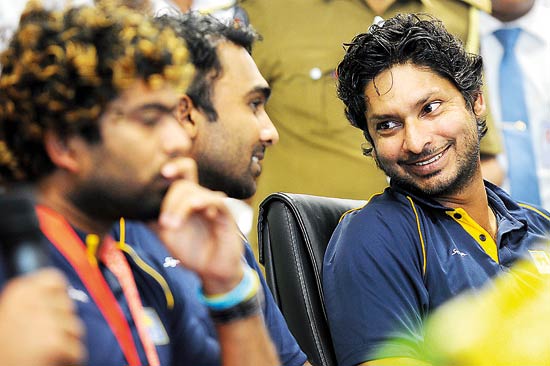Distinct flashback on previous successes and line in with evolution
According to Mr. Dharmadasa, the main reason for the loss wasn’t poor planning, inconsistent selection, or lack of preparation. No, it was because Wanindu Hasaranga’s substitute “did not do the job properly.” One man’s hamstring, it seems, now carries the entire weight of our national cricket team. But facts prove that the picture is far less flattering.

Sri Lanka's T20 World Cup trump in 2014 was due to the result of combined efforts of the seniors - File pic
Since 2020, Sri Lanka have played 83 T20 Internationals and won just 32. Sri Lanka’s win/loss ratio is 0.680—level with Ireland. Yes, Ireland. The team more associated with stout than cricketing strength.
Compare that with the period from 2010 to 2014. Sri Lanka were world leaders in T20 cricket. The win/loss ratio was over 2.0. Kumar Sangakkara led with grace, Mahela Jayawardena with vision, and Lasith Malinga with thunderbolts. We were respected. We were feared.
Now, others have evolved. They use data. They build depth. They plan every detail. We, on the other hand, still seem to believe watching replays of the 2014 final counts as strategy.
In the last year and a half alone, Sri Lanka have tried over 20 players in T20Is. That’s not rotation—that’s guesswork. While India and England are grooming clear role-specific players, Sri Lanka is still handing out caps to anyone who had a good week in domestic cricket.
Hasaranga is without doubt a rare talent. But we ask too much of him. Bat in the top order, bowl four overs, and carry the team every other match. This is no longer sustainable—unless Sri Lanka Cricket are secretly working on cloning him.
Meanwhile, other countries are moving forward. India use analytics to plan their line-ups. Australia trains finishers with military precision. Even Bangladesh now have a structure. And Sri Lanka? We’re still talking about “playing with heart”—as if that’s a tactic.
Our average run rate is 7.65. That might have worked in 2014. In today’s game, it simply isn’t good enough. Our fielding is patchy, our death bowling is erratic, and our plans often depend on who’s injured and who’s in form.
Our public relations, however, are in top form—especially when it comes to finding excuses. What’s needed now is a shift in mindset. First, we must accept where we stand. We’re not contenders right now. If we carry on like this, we won’t even remain competitive.
But all is not lost. The raw talent exists. Kusal Mendis, Pathum Nissanka, Charith Asalanka, Hasaranga, Matheesha Pathirana—these are players to build around.
Emerging names like Nuwanidu Fernando, Shevon Daniel and Lahiru Udara need real opportunities, not the odd match between defeats and damage control interviews. Strike rate matters now more than ever. A quick six-balls 20 is often more valuable than a slow 40 of 38. T20 cricket rewards intent and clarity. We need to recognise that.
Our death bowling continues to be a weak link since the retirement of Lasith Malinga and Nuwan Kulasekera. Hasaranga often completes his spell before the 15th over, leaving the final phase of the innings to whoever happens to be on the field. It’s time to properly train the likes of Matheesha Pathirana, Nuwan Thushara, and Eshan Malinga in the skills required to close out games: wide yorkers, slower balls, control under pressure.
Spin remains our strength. But two spinners are no longer enough. A third must be developed. Whether it’s Dunith Wellalage, Jeffrey Vandersay, or Akila Dananjaya, we need to identify them now—not in a panic six weeks before a World Cup.
The 2026 T20 World Cup is not just another tournament. It’s a turning point. We either show we’re serious, or we risk becoming a team that simply hosts matches and watches others succeed. This demands honesty. Tough, uncomfortable honesty. No more picking players out of sentiment. No more giving farewell tours disguised as squad selections. Cricket has moved on. So must we.
That means using data, defining roles clearly, and rewarding performance—not past reputations. And yes, it means asking difficult questions. Like why our Vice President is making sweeping claims while the results tell a very different story.
The next six months are critical. This is not the time for nostalgia or feel-good stories. It’s the time to build properly. Because if we fail in 2026, it won’t just be another bad result. It will be a painful tale of squandered potential—narrated by those still clinging to the myth of our greatness.




